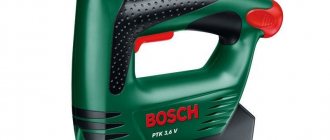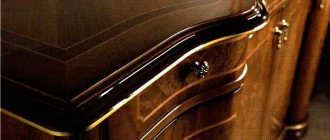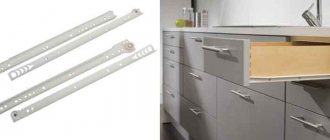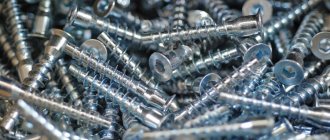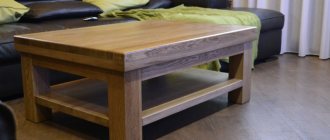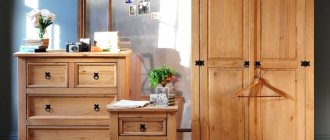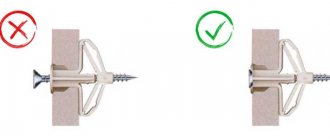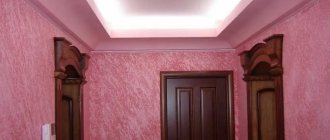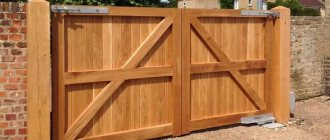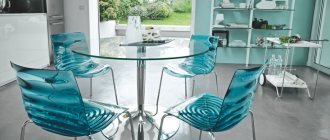- mechanical or manual.Activated by hand force. Low power is a disadvantage of such devices. But there are also advantages: light, cheap, compact. Mechanical staplers are reliable in operation, as they consist only of a body, a lever and a spring mechanism. There are two types:
- lever To hammer in the equipment, you need to press the lever;
Hammer or impact stapler
Mechanical staplers come in the following types:
with a coil spring. Has a weak shot. Allows you to work only with soft wood. Gives noticeable feedback to the hand. Resource up to 12,000 shots;
Coil spring stapler
Stapler with spring
- household These are mechanical and cheap low-power models of electric staplers;
- professional. These include more powerful electric and pneumatic tools.
Types of staplers by type of equipment:
- staplers. Used for household work;
- nailers. Used for professional and household activities. Work with large staples and nails. The length of the equipment is more than 12 mm;
- universal. Can work with flat and round staples, nails and pins.
Choosing a furniture stapler and staples. Don't confuse the type of bracket!
A furniture stapler is widely used in the household; with its help you can easily nail down greenhouse film, cover furniture with fabric, and it will also come in handy in other situations.
The variety of models will confuse the ignorant person, so in this article you will find useful tips on choosing how to use it, which brackets are suitable for which models. There are a wide variety of home staplers on sale; the first thing you need to pay attention to is the type of staple. The most popular and frequently used type of staple is type 53. Most models use type 53. This type has the following dimensions: staple width 11.4 mm, thickness - 0.7 mm. Of course, you don’t need to know these dimensions, you just need to know what staples your “pigalle” works on and their type.
Secondly, what depth of staples can be driven in.
Furniture guns can be simple (staples 4-8 mm deep, inexpensive). Most often made of plastic, intended for infrequent use. Only small staples are used, so they can only be used to nail fabric or paper. Cheap and simple, the price is about 100 rubles. Like these ones.
There are also options 4-10 (staples from 4 to 10 mm inclusive). Such pistols are already made of metal, although there is no adjustment screw. Yes, it is of no use, the staples can be driven in 10 mm without maximum adjustment. As a rule, type 53 staples are used.
Staplers 4-14 mm (the very first photo in the article). The most popular and best-selling. Made of metal, solid, high quality. Use staples 4-14 mm deep with 53 type. The main difference from others is the presence of an adjusting screw, with which you can increase or decrease the impact force. As a rule, if the staple is more than 10 mm deep, then the screw must be tightened in the direction of increasing the impact force, otherwise the staple will not completely enter the wood. A wide range of bracket sizes (4,6,8,10,12,14 mm) will allow you to choose the optimal depth for the job. Among the good models, we can highlight reliable and high-quality ones, the price is 330 rubles.
Also among the household models, it is necessary to highlight the model with bracket type 140. It is thicker, has dimensions: width 10.6 mm and thickness 1.2 mm. If you load type 53 staples into a type 140 stapler, it will shoot 2 staples at a time. Therefore, it is so necessary to know the type on which “pigalle” works. Most often, guns with 140 type support several types of staples, these are small nails and semicircular staples for driving in cables. We can say that this is a universal option, which is a pleasure to work with. However, it does not support the most popular type 53 bracket. The Stayer stapler, shown in the photo below, supports 4 types of staples: type 140, type 300, type 500 and type 36. Its price is 650 rubles.
Read more about braces below.
- the most used, used in most staplers.
Rectangular Bracket width 11.4 mm Thickness 0.7 mm. Dimensions (depth) 4-14 mm. Sold in packs of 1000 pieces. There are 2 types: hardened and simple. Tempered ones are used for strong or laminated wood (chipboard). Regular staples are 2 times cheaper and are designed for soft wood.
Powerful, thick staples are also used for fastening material to wood, plywood, and chipboard. Rectangular bracket. Width - 10.6 mm Thickness - 1.2 mm Dimensions 4-14 mm Packages of 1000 pieces. The cost is higher than that of type 53 staples.
Semicircular brackets for cable fastening. Bracket width - 7.6 mm (cable with a diameter of no more than 6.4 mm can be pinned) Thickness - 1.2 mm Dimensions - 10, 12. 14 mm
Small carnations with a T-shaped head. Used for fastening to wood, wood, chipboard. Nail thickness - 1.2 mm Dimensions - 10, 12 and 14 mm.
Carnations without a cap (finish type). In general it looks like type 300, only there is no cap. Dimensions - 10,12, 14 mm.
If you are engaged in furniture production and use the corresponding tool constantly in hard mode, then ordinary household models will not last long. Therefore, there are professional options for such purposes. The RAPID tool has proven itself to be excellent. This company specializes in the production of only furniture guns, so they are of excellent quality. However, their cost is rather high, for example. A standard gun for type 53 staples costs 2,200 rubles. However, according to reviews from customers who bought a couple of these models from us, they are very strong. Before that, they bought ordinary household ones, but they often broke down. Therefore, it was decided to buy 1 professional one for testing - it outlasted 10 conventional staplers. As you can see, the difference is simply huge. For home use, an ordinary inexpensive one, for example, will be enough.
How to insert staples
For those who are picking up a stapler for the first time, this can be a problem. But after the first time you will learn right away, nothing complicated. Here's a photo for you.
First, take out the “staple pusher” with the spring from the gun, then insert the staples with the point down and push them in with the “spring thing” until it clicks into place.
How to use a furniture stapler: device, operation, tips
A furniture stapler is a fairly universal tool with which you can not only perform furniture upholstery procedures, but also a number of other construction operations.
Today, there are several types of similar equipment, differing in their operating principles:
Pneumatic staplers are used in industry, and electric and manual staplers are used in everyday life. Models belonging to the latter type are the most common in the furniture industry due to their mobility and ease of use. Let’s use this example to look at the principle of operation, operation and repair of furniture staplers.
However, before moving on to this procedure, I would like to say a few words about staples and their varieties.
How to choose staples for a furniture stapler
Construction staplers are widely used today by specialists in various professions. It is used to connect various materials. The presence of many other names, for example, tacker, staple gun, staple gun, nailer, emphasizes the popularity and versatility of this tool. But to operate such equipment, you need consumables: staples, nails or pins. In practice, the first fastener option is most often used. Consumables differ in shape, material from which they are made, geometric parameters and other characteristics. The dimensions of the staples for staplers are the determining factor when choosing the appropriate fastener for the model being used.
Electric staplers.
Advantages: Ease of operation - the force is created by a striker powered by electricity; you just need to press the button with one finger. Excellent for home use and reupholstering furniture at home. Some models of electric staplers allow you to perform work at a professional level.
Disadvantages: Perhaps it is worth noting the relatively low rate of fire (according to the instructions - 20 beats per minute, in practice you can shoot as quickly as you like, but tool wear increases). Their work resources are small. They can bend staples and miss shots. It is also difficult to position the staple, but there are models with long spouts that allow you to do the job more accurately.
Tips for choosing: Price from 1300 rubles (Chinese crafts). If you are planning to reupholster one sofa, perhaps such a simple electric stapler will be enough for you. But one sofa and armchair may no longer be enough. A quite good electric stapler can be bought for 4,000 rubles. (in 2010 prices). When purchasing, you need to check the impact force (especially for hard material, such as chipboard) and pay attention to the type of staples that are suitable for this stapler (price of staples, availability). Today it is worth paying attention to electric staplers from Novus. Novusov has the largest assortment and an adequate price/quality ratio. Bosch currently offers only one model and that one is green (according to the Bosch classification, green is a tool for performing work at the household level). Having tried the entire line of Novus staplers suitable for furniture upholstery, for professional work I settled on the Novus J 165 EAD model. In addition to a truly powerful punch, this staple gun has a convenient spout that allows you to reach hard-to-reach areas and precisely position your staples.
Existing types and sizes of staples
Staples for construction staplers are divided into separate groups according to different criteria, the main ones being shape and size. Based on the first sign, consumables come in the following varieties.
- U-shaped is the most common in practice, the most universal rectangular version of fasteners.
- U-shaped - an arched variety designed for securing wires and cables for various purposes, as well as different cross-sections.
- T-shaped (pins, nails) are the most rarely encountered consumables in practice, allowing you to make a connection that does not bear any load, in the most hidden way.
Few models of staple guns can work with all three varieties. For most tackers, only U-shaped fasteners will fit.
U-shaped fastener parameters
Consumables in the shape of the letter “P” are characterized by three sizes:
- the length of the leg or the height of the bracket (denoted by the Latin letter H), which determines the maximum possible depth of immersion of the fastener into the surface of the base material;
- the width of the “back” (the length of the bracket itself, indicated on the marking as L or b), which is taken into account if it is necessary to mask the connection point;
- thickness (width, designated W or a), which determines the strength of fasteners made from different materials.
All dimensions on the markings are presented in millimeters. The photograph shows U-shaped and T-type fasteners with the letter designation of their individual parts.
It should be taken into account that the shorter the length of the bracket, the less load the fastening can withstand.
Of the entire significant range of U-shaped brackets, the following types are most in demand in practice:
- 53, having a staple thickness of 0.7 mm, a length of 11.3 mm and a stem height of 4 to 14 mm;
- 140, characterized by a significant degree of rigidity, with dimensions: H - 6÷14 mm, L - 10.6 mm, W - 1.25 mm.
Other existing types of U-shaped consumables by standard size are rarely used.
Types of U-shaped and T-shaped consumables
Arc-shaped fasteners are intended for special modifications of furniture staplers. There are only two types of such fasteners:
- 28 (otherwise denoted by the capital letter S), designed for securing a cable with a cross-section of 4.5 mm, having a clip thickness of 1.25 mm, and a leg height of 9÷11 mm;
- Z6 (L is also written in the marking) is a semicircular fastener with a thickness of 1.25 mm, a leg height of 6÷10 mm, used when fastening a wire with a diameter of 6 mm.
Bracket material
Staples for an electric stapler (as well as for mechanical and pneumatic ones) are made from different materials. According to this criterion, the following types of fasteners are distinguished:
This determines not only the properties of fasteners, but also indicates the scope of their application.
Steel consumables for construction staplers
Due to their significant strength, steel staples are used in practice most often in various fields of activity. They may be hot or not. The first ones are used if you have to work with hard material. They are good to drive in, but they break more easily, unable to withstand lateral loads.
The main disadvantage of both types of steel fasteners is their susceptibility to corrosion: they rust over time. Corrosion processes occur especially quickly in humid conditions. This not only spoils the appearance of the connection, but also reduces its strength.
Staples for construction stapler Steel 62125, T50, 14x10.6 mm
To extend the life of steel brackets, they are coated with zinc. Galvanized products are quite resistant to destruction, so they last many times longer.
Also, to prevent corrosion, fasteners are made from stainless steel. Such products are more expensive than products made from ordinary metal. Stainless steel staples are very reliable because they are resistant to destruction. Galvanized and stainless steel consumables are produced mainly by well-known manufacturers who are concerned about their reputation.
Aluminum and copper fasteners
Aluminum staples are a cheap option. The products are resistant to corrosion, but have low strength: they can easily bend when driven in or burst from a relatively small load. For these reasons, the scope of application of aluminum consumables is limited to working with soft materials: assembling cardboard containers, securing electrical wiring, as well as light cladding.
Copper staples for furniture staplers are stronger than their aluminum counterparts. They are also resistant to corrosion and are suitable when working with soft materials. In addition, the high cost limits the distribution of copper fasteners: they are used mainly for decorative finishing.
How to choose a device: advice from professionals
To choose the optimal stapler, you need to solve the following problems for yourself:
- frequency of use of the tool: every day or from time to time;
- places of use: indoors, outdoors. Is there electricity there?
- Do you need precision driving of equipment;
- materials you plan to work with.
Depending on the purpose and working conditions, choose the type of stapler:
- for infrequent work with non-solid materials, a mechanical stapler is suitable;
- If you don't need precision in installing staples and have the ability to swing, then consider choosing an impact stapler. He's light. Attached to the mounting belt;
- for a large amount of work in places where mobility is needed, take a closer look at a cordless tool;
- if you work indoors with an outlet and don’t want to overpay for the battery, buy a stapler with a mains connection;
- If you need a stationary powerful device, don’t hesitate to take a pneumatic tool.
What characteristics to look for when choosing a stapler:
- presence of impact force regulator. A mechanical tool has two types of regulation: minimum and maximum or smooth adjustment. Electric has up to 6 modes. The setting is made using a software switch. The thinner the material, the less the impact force, otherwise dents will form;
- Double punch. Only electric staplers have it. For hard materials, large equipment is used that will not clog immediately. The double strike mechanism itself determines this and works a second time. If there is no such mechanism, then you will not immediately see that the nail heads are not completely hammered in;
- removing fasteners using a stapler. If this function is available, then to remove poorly hammered equipment you will not have to do it manually or with a nail puller;
- body material. Structural steel staplers weigh more than plastic ones;
- rubber inserts on the handle. Their presence reduces the recoil of the tool, and the hand gets less tired;
- Battery type: nickel-cadmium suitable for low temperatures. But they have a memory effect, so they discharge quickly. They are used in inexpensive models;
- lithium-ion. They hold a charge longer, but are less resistant to mechanical stress;
- nickel metal hydride. Lightweight and have a long charge life;
Selecting staples for a stapler
When purchasing staples, you should know which staples will fit your stapler. The type of equipment is indicated on the packaging, in the instructions and on the tool body. Staples have characteristics that must be taken into account when choosing:
- form. It can be U-shaped or semicircular. The latter is used for cable installation;
Source: dm-st.ru
Correct selection of staples according to tool model and type of work
To choose the right consumables for the job, you need to focus on a number of criteria:
- the type of fastener for which the staple gun in use is designed, as well as its shape;
- the material of the base surface into which the fasteners are to be driven;
- future conditions in which the fasteners will be located after connecting the parts;
- the material from which consumables are made;
- sharpness of the ends of the staples;
- quality of consumables.
For instructions on the appropriate size and type of charging fasteners for the model of staple gun you are using, please refer to the packaging or the tool's instruction manual. These are mainly U-shaped consumables. The fastener number on the marking is represented by 2 numbers: the first indicates the width of the bracket, and the second indicates the height of its leg.
The choice of consumables from the size range designated by the staple gun manufacturer is based on the magnitude of the future load on the fastener: the higher its value, the larger the dimensions of the fastening element should be . If the base material is hard, then steel or hardened staples are suitable. It is better that they have pointed ends - this will ensure easy driving in.
When it is necessary to make a connection point that is not subject to loads as inconspicuous as possible, consumables of the smallest possible size should be used.
For use in wet conditions, copper, aluminum, galvanized, or stainless steel staples are suitable. The optimal option depends on the hardness of the base and the degree of the upcoming load.
Cost and packaging of staples
Fasteners for staple guns are sold in boxes. Moreover, one package can contain from 500 pieces to 5000 staples, fastened with adhesive film into separate blocks. They fit completely into the tool magazine or need to be divided into parts of the required size.
It is more convenient for work to select consumables that immediately fit the length of the block.
Prices for consumables, depending on the manufacturer, range from tens to hundreds of rubles per 1000 pieces. The difference is related to the metal from which enterprises make products. It is recommended to purchase more expensive, but high-quality fasteners. Cheap consumables often bend or break when driven in. This significantly affects the duration and quality of work.
Staples Stanley type-A (5/53/530) 8 mm
There are no trifles in the work of a professional. The correct choice of fasteners in size and material will not only increase labor productivity, but also improve the quality of the result. In addition to the types of brackets for tackers considered, some manufacturers produce consumables of non-standard sizes and shapes. Such fasteners are only suitable for special modifications of construction tackers. Often such a tool is designed to perform only certain, specific types of work.
Types of staplers
Furniture staplers come in several types. Depending on the complexity of the design and performance, they are divided into three categories.
The simplest model is a manual stapler . To connect materials, the craftsman only needs to apply physical force. The device is easy to maintain: just lubricate the parts of the universal tool regularly. A handmade product will serve the owner for 5-7 years.
The mechanical model is convenient for performing many operations in everyday life. When working with large volumes, the use of physical force tires the master. You shouldn't expect high performance from the device.
A furniture stapler with an electric motor is suitable for medium-sized work in the professional field. To use the device, a connection to an electrical network is required. Some manufacturers produce models that operate on a rechargeable battery. The staples can be removed from the holder by pressing a button on the device body.
Thanks to the operation of the electric motor, the impact force increases many times. Hard surfaces are easily penetrated, the fastening is strong and reliable. A type of power tool is a construction stapler, intended for use in finishing premises.
The disadvantages of the electrical device are high cost, large dimensions and heavy weight. In addition, the limited length of the cord does not allow working a large area.
Electric models in most cases often break down due to incorrect choice of brackets or violation of operating rules. Beginners or inexperienced users should buy mechanical models for everyday use.
Productive and reliable are models that operate using a compressor . Such a tool is used in furniture industry enterprises, where it is possible to equip workplaces with an air supply and a dedicated separate electrical line. Such devices are not used in everyday life.
Instead of a spring, such pistols are equipped with a pneumatic cylinder. Such a unit sets in motion the air that enters when the trigger is pulled. This mechanism increases the workforce and allows the master to cope with a large volume of work. The average speed of the gun is one staple per second.
Pneumatic models do not require complex maintenance. To extend service life, periodically clean and replace the O-ring. The disadvantage of the unit is its stationary nature. The radius within which the air gun operates is limited by the length of the hose that supplies the air.
Materials for production
Staples for furniture staplers are made from various types of metals. This allows you to select a material with the most suitable properties. There are several main types of metal:
- aluminum is the cheapest material with low rigidity. On a solid frame and when there is a heavy load on the joint, fasteners made of this metal are not used, as they bend and break. But aluminum is resistant to corrosion, which is one of its advantages;
- copper is a soft but corrosion-resistant expensive metal;
- steel - two types of fasteners are produced: hardened and without hardening. The first is higher in strength, but more expensive. Both types are susceptible to corrosion;
- plain stainless steel or zinc-coated - such elements are highly durable and are considered the most popular type of staples.
The choice of metal for staples is carried out taking into account the place of their use and purpose. It is also worth paying attention to the budget allocated for repairs and the cost of materials.
Mechanical (spring) stapler.
Advantages: cheap, lightweight, you can work anywhere, regardless of the availability of electricity.
The disadvantages are clear from the name - mechanical, it requires effort to work. The force is generated by a metal spring that you squeeze with your hand before impact. Large volumes cannot be covered with this stapler - you are guaranteed to get calluses on your palms. You can cover the seat of a chair, stool, ottoman, or a simple kitchen sofa. It is inconvenient to position the staple if you need to hammer it into a precise location. Another drawback is the difficulty of driving staples into hard-to-reach places, because when working you need to not only compress the stapler spring, but also at the same time firmly press the stapler itself to the part being stapled.
Tips for choosing : The easiest way to hammer the bracket into solid coniferous wood (pine). If you plan to work with harder materials, such as chipboard, then you need to choose a more powerful stapler. The power of a mechanical stapler can be easily determined by looking at the characteristics of the maximum length of staples used. If one stapler hammers a maximum of 8 mm staple, and the other 14 mm, the choice is obvious. Also pay attention to the type of bracket and its commercial availability.
Types and sizes
Each furniture stapler has its own type of staples. There are a large number of them and they all vary in size. The most commonly required staples are suitable for furniture staplers of type 53 and 140. They have the following parameters:
- 53 — back width 11.3 mm, thickness 0.7 mm, leg height (depth of entry into the material) from 4 to 14 mm;
- 140 - width 10.6 mm, thickness 1.25 mm (almost 2 times the previous one), height 6-14 mm.
Staples for furniture staplers can have the same dimensions but have different names. This is due to the characteristics of their manufacturer. Each type of fastener has its own parameters. They mean the following:
- width characterizes the strength of the material (for use on thin fabric, take wide ones, but when working with plywood, this size does not matter);
- thickness (length of the staple) is needed to assess the possibility of hiding the fastening, but not every stapler can work with a short staple, and this also reduces the fastening force);
- height (length of the leg) characterizes the thickness of the canvas on which the fastening is made, taking into account the depth of entry into it.
Nails and hammer.
Old school. If there is a need to reupholster the seat of a stool or chair, then you can get by with nails and a hammer. You can even use an old Soviet sofa-book. Wallpaper nails should be used with a large head and a short stem. You can use push pins as a large hat. There are also special furniture nails with large decorative heads. They are used to upholster visible parts of furniture; working with them is the job of professionals.
Advantages: available in every home.
Disadvantages: Very low speed. You may need the help of a partner, because it is extremely inconvenient to simultaneously stretch the fabric and hammer in nails. As a rule, the result of such upholstery does not look very neat. It is much more convenient to work with a stapler. If you like to work with your hands, then I advise you to buy at least a mechanical stapler.
Nuances of choice
A staple for a furniture stapler may have sharpened legs. They fit into the base more easily, and the power on the device is set lower than usual. This saves energy consumption and increases the service life of the automatic stapler. If a hand-held device is used, less effort is required to secure it. This allows you to work longer and get less tired.
Before going to a hardware store, you need to think about what staples are best for use in a furniture stapler given the situation that arises during the renovation. If high humidity is often maintained in the room (bath, sauna, bathroom, balcony), then the choice should fall on corrosion-resistant metals. These include copper, aluminum and stainless steel. This will avoid rusty stains on the materials and also prevent the destruction of the structure.
If it is known that the load on the fasteners is designed to be small, it is advisable to install them from aluminum. This choice is especially good for vapor barriers and wiring. In this case, you need to take into account the level of hardness of the base material, because aluminum is quite soft and may not fit into it.
For fastening lining or other hard and massive materials, it is better to choose stainless steel clips. They will be able to support the weight of the structure and are not subject to destruction from water. If in such a situation you install aluminum fasteners, the wood will absorb water and bend the holding elements. The structure will become fragile and may collapse.
The staples are packaged in boxes of various sizes. They come in 500, 1t, 2t, 3t, 5t pieces per package. The staples are fastened together with an adhesive compound into blocks of several pieces. This is necessary for ease of filling the stapler. The length of the block does not always correspond to that of the device, but the paper clips are easily separated from each other, allowing you to adjust the size.
When choosing staples, you need to take into account not only the approximate quantity required for repairs, but also the percentage of possible defects. If the master working with the stapler is inexperienced, and the staples are fragile or soft, you should take at least 50% of the expected number in reserve.
The price of paper clips ranges from 30 rubles. up to 212 rub. of the same type (53), but from different companies. Inexpensive fasteners are produced by Saturn, and the most expensive ones are produced by Bosh. The cost depends on the material used. The higher it is, the stronger the metal. This means a lower percentage of defects and ease of use. Therefore, sometimes it is better to choose more expensive, but high-quality fasteners, and spend less time and effort on the work.
Stainless steel staples are expensive, but at the same time they successfully combine corrosion resistance and strength. This material is especially relevant in rooms where reliable fastening is required, but high humidity is maintained (bathrooms, baths, saunas). These paper clips are produced only by large companies that are ready to be responsible for the quality of their products and their considerable price.
Fasteners made of copper are stronger than those made of aluminum; they are also non-fragile and resistant to water. They are often used in decorative structures due to their color and properties. But copper staples are expensive, so their use is not as widespread as aluminum ones.
When choosing steel fasteners, production technology is taken into account. Hardened products are more durable, but their cost is higher. They are chosen for hard surfaces that softer metals can bend on. They easily fit into the main fabric, but under lateral load the fasteners cannot withstand and break in half.
When choosing paper clips, not only the type of room in which the work will take place is taken into account, but also the materials used. If it is necessary to secure the back surface of a cabinet made of hardboard or plywood, use simple steel fasteners. It is better to choose galvanized ones to avoid corrosion, but regular ones will do. In chipboard, staples are easily fixed, but do not hold well. Therefore, it is better not to move furniture assembled in this way or subject it to heavy loads. Since the thickness of the chipboard is considerable, high staples are needed, with a long leg.
To work with upholstered furniture or upholstery of chairs, you need to choose paper clips with a large width and sharp legs. Stainless steel and copper are good materials. The large-width staples fit neatly into the fabric without disturbing its integrity, and the pointed legs can be easily inserted into any material, including wood.
Instructions for use
To understand why a furniture stapler bends staples, you need to check whether they are inserted correctly, and also compare the material of the base and the staple. The required fastener characteristics are indicated on the tool label. You need to study it carefully and choose exactly the brackets that are indicated.
If you have taken the necessary staples, but the furniture stapler does not hammer in the staples, there may be several reasons:
- tool malfunction;
- discrepancy between the selected metal and the hardness of the base;
- blunt ends of the staple if there is an obstacle to its entry into the material;
- incorrectly threaded stapler;
- unadjusted instrument.
Before work, you need to make sure that this type of paper clip is suitable in shape and size for the stapler. If these parameters do not match, the tool will not work. The exact description of the required consumables is indicated on the box for the stapler or on a sticker located on the body of the tool.
How to insert staples into each specific stapler is indicated in its instructions. Usually they are located with sharp edges down on a special holder with a spring. It is filled all the way so that the stapler lasts a long time. The exact number of paper clips is indicated in the instructions. It is in the box with the stapler.
If the tool is mechanical, then it needs to adjust the screw regulator (if equipped). The greater the depth of the staple, the tighter the handle should be tightened. Sizes from 10 mm are taken into account.
The adjustment is checked on an inconspicuous place or unnecessary material, identical in properties to the base. The adjustment is carried out gradually, from the minimum position to the maximum. Adjustment is carried out until the bracket enters the base with one blow. Once the tool is set up, it can be used directly on the part.
In order not to make a mistake in the distance from one bracket to another, mark it with a pencil. Some staplers have a lock that allows you to set the desired length between the staples without basting. It is better to insert the staples not parallel to the edge of the sheet, but with an inclination of 45°
To ensure that the edges of the product look neat and do not have to redo the work, the material is held while driving the staples. It is necessary to check after each row that the required number of paper clips is present. When upholstering upholstered furniture, the distance between the fasteners should not be too small to prevent damage to the fabric. It is best to insert paper clips into the fold of the material, which will extend the life of the product.
Review and modification of the furniture stapler
Good afternoon, dear readers! I decided to share with you information about a good furniture stapler and its slight modification.
The stapler was purchased on Aliexpress, link – https://ali.pub/37ymb1
How to buy profitably on Aliexpress, see here
March coupons for the site's birthday
$5 discount when purchasing over $25 (coupon 5/25), link ( https://ali.pub/378ovx )
$6 discount when purchasing over $30 (coupon 6/30), link ( https://ali.pub/378p0e )
$8 discount when purchasing over $50 (coupon 8/50), link ( https://ali.pub/378p3w )
You can take no more than two coupons of each denomination. You must first log in to the site! Coupons expire on April 1st. Coupons 6/30 and 8/50 appeared relatively recently, so they are taken without problems.
If you manage to get a coupon of a large denomination, but you need to buy a cheaper product, we use the so-called “add-on”. To do this, we bring the cart up to the coupon value, apply the coupon and click “Checkout”. We do not pay for orders. Go to my orders, select the one you need and pay for it. The discount on the coupon will be distributed in proportion to the amount of orders.
I didn’t plan to write a review, since I’m more of a reader than a writer, so I apologize in advance if I missed any points.
A stapler is a tool designed for fastening a particular material by driving staples:
Despite the rather simple device, the tool is very useful for various construction or household work. It is mainly used at dachas for attaching film to greenhouses, attaching hydro or vapor barriers, insulation tapes, upholstery and other work.
The stapler arrived in a regular postal package. There was no useful information on the packaging, so I threw it away as unnecessary. Judging by its appearance, the stapler is perfectly new, without scratches or other defects. I've already worked on it a little, but it's still like new:
Like most such devices, the stapler is equipped with a safety (transport) bracket:
In the working position, the lever protrudes quite strongly, so it will be more convenient for people with long fingers to work with it:
The stapler uses regular staples in several sizes (4-8mm and 4-14mm):
I use fairly cheap 10mm staples:
They have an optimal height and thickness of 1.25mm
Design:
Its design is similar to those sold in our stores, with the exception of some important aspects:
- the case is completely made of metal - allows for rough handling and accidental falls, and also allows you to count on some strength and durability
- extended spring compartment with a stiffer spring - you can count on good impact force
— adjusting screw — allows you to change the impact force when working with soft or brittle materials
What I saw in our stores for 300-400 rubles - either with a plastic body, or low-profile with low impact force. Analogues start from 500 rubles.
The design is incredibly simple:
Using the lever, the working spring is cocked and in the uppermost position the firing pin is released, which, under the action of this same spring, hits the bracket, pushing it out of the magazine. The force of the impact directly depends on the stiffness of the spring.
Spring-loaded staple supply unit:
The magazine itself is removable, so if the staples get stuck, you can easily pull it out and fix the problem:
It rests on these two supports:
Before removal, you must first remove the staple supply unit, otherwise they will quickly fly out:
The firing pin is, of course, metal:
The adjusting screw has some peculiarity and does not tighten completely (maximum impact force), but rests against the protrusion of the housing:
If you unscrew it, you can feel the spring of the impact mechanism:
It is generously lubricated with thick lubricant, which in itself is a big plus.
Dimensions:
The sizes are small, it fits comfortably in the hand:
Now for the improvements:
Despite the high-quality execution, there was not always enough energy, so the idea arose to slightly modify the design. To evaluate the modification, I used regular seven-layer plywood and a piece of compressed wood board:
Let me warn you right away that the slab is very dense and not all nails can be driven into it. When setting the maximum force, the stapler was unable to completely drive the staples into either the slab or the plywood:
Therefore, first of all, unscrew the adjusting screw and tighten the stop:
This will give us another four millimeters:
The effect becomes noticeable immediately and you can stop there. But I recommend modifying the screw a little more, thereby compressing the spring of the impact mechanism even more, since it has a good length:
To do this, you need to put several washers on the screw:
It’s good if you have the ones you need in your bins, since not all washers will fit. You need to select a washer so that it sits on the protruding “neck” of the screw, i.e. had the appropriate diameter and fit through the mounting hole in the body. I found only one suitable washer out of a whole bunch, which also had to be drilled out a little:
Of course, if you don't have the right ones, you can buy a couple of them at a hardware store, or use Grover washers, they fit perfectly:
But with them it is difficult to adjust the force, since they rest against the end of the spring and make it difficult to turn the adjusting screw. On the other hand, adjustment is not required so often, so this can be neglected.
After all these movements with the adjusting screw tightened, the staples completely pierced the plywood, but they still couldn’t cope with the slab and simply moved the staple:
The photographs show that the impact force has increased several times. The stapler copes with ordinary wood with a bang, but it is now used very rarely. There are no problems with fiberboard and HDW, and these are the most popular materials in furniture production. After modification, I had already successfully “fired” the old chair and did not have to finish off the staples with a hammer anywhere. Without modification, they only went to the middle, which prompted me to do this “doping.”
The only disadvantage of this modification is increased wear (depletion) of the striker stop:
It can also be easily fixed with a simple file, but you will need to completely disassemble the stapler.
In general, I recommend any metal stapler for modification, especially low-profile ones with low impact force.
The stapler was purchased on Aliexpress, link - https://ali.pub/37ymb1
How to buy profitably on Aliexpress, see here
March coupons for the site's birthday
$5 discount when purchasing over $25 (coupon 5/25), link ( https://ali.pub/378ovx )
$6 discount when purchasing over $30 (coupon 6/30), link ( https://ali.pub/378p0e )
$8 discount when purchasing over $50 (coupon 8/50), link ( https://ali.pub/378p3w )
You can take no more than two coupons of each denomination. You must first log in to the site! Coupons expire on April 1st. Coupons 6/30 and 8/50 appeared relatively recently, so they are taken without problems.
If you manage to get a coupon of a large denomination, but you need to buy a cheaper product, we use the so-called “add-on”. To do this, we bring the cart up to the coupon value, apply the coupon and click “Checkout”. We do not pay for orders. Go to my orders, select the one you need and pay for it. The discount on the coupon will be distributed in proportion to the amount of orders.
How to use a stapler
Refueling
In order to load the stapler with staples (i.e. load the staple gun), you must first move away the spring intended for pressing them. The staples themselves are placed in a special groove, in which, in fact, they need to be placed. After this, the spring is put in place. The tool is completely ready for use.
Video: how to thread a stapler with staples
Now you know how to insert staples into a stapler, we can proceed directly to work.
Shot
In order to fix the necessary element, you should firmly attach the device to the place where you plan to hammer the bracket. After this, without lifting the device from the surface, you must press the trigger button (lever). If these manipulations are successful, you will hear a characteristic sound and see a staple inserted into the material.
Tips and tricks
In order to protect yourself when working with a construction stapler, you should follow some rules:
- If you use a mechanical model of the device, it is necessary to adjust the screw regulator. This operation should be performed on a piece of rough material by rotating the screw from minimum to maximum. If the staple goes in all the way from the first shot, you can start working on the “finishing” part. Otherwise, re-adjustment is required;
- In order to drive the staples at the same distance, you should first mark the necessary places with a pencil or ballpoint pen;
- Hold the material with your free hand so that when firing it does not move from the pre-designated place;
- Keep track of the number of staples in the “store” so as not to be left without a single fastening element at the most inopportune moment;
- After finishing work, secure the handle with the safety catch to prevent spontaneous or accidental firing.
In addition to all the above tips, you may also need help repairing this construction tool, since the stapler, like any other equipment, tends to break.
Repair
The most common cause of stapler failure is a breakdown of the impact mechanism . However, in order to get to it, you must first disassemble the tool. This can be done by performing a number of simple operations:
- Remove the adjusting screw;
- Remove the spring;
- Remove the protection cover;
- Remove the pins;
- Remove the lock washers.
If the list of actions does not make it clear to you how to disassemble the stapler, then you can see this in the video below.
After performing all the above manipulations, you will be able to see the drummer, which, for the most part, fails due to the exhaustion of its resource.
In order to repair this element, you should remove it, place it in a vice and, using an ordinary file, give the striker its original shape.
That's it, the repair is completed, and the instrument is again in full combat readiness.
Tips on why the stapler does not work and how to fix it:
- If your tool does not finish (does not finish) the staples, then try tightening the spring, it may have weakened;
- If a construction stapler bends the staples, try adjusting the spring tension bolt (relax or tighten, experiment). Another probable cause of malfunction is a mismatch between the type of staples and the structure of the material - for chipboard and plywood it is recommended to buy staples made of hardened steel;
- If the staples do not come out of the stapler, but bend and get stuck inside, perhaps the striker (tongue) that pushes them has become rounded and needs to be sharpened;
- If the mechanism itself works, but the staple does not fire, it is possible that the staple does not grip, or the firing pin has worn out. Try filing the firing pin and turning the damper with the other side.
Watch the video to see how to repair a staple gun with your own hands.
Video: do-it-yourself stapler repair
How to disassemble a furniture stapler, what to do if it jams. What could be the reason, what to do if the construction stapler does not fire staples:
The real-time video shows step by step how to disassemble the stapler, what could be the cause of the breakdown and how to fix it yourself, as well as how to assemble the stapler.
